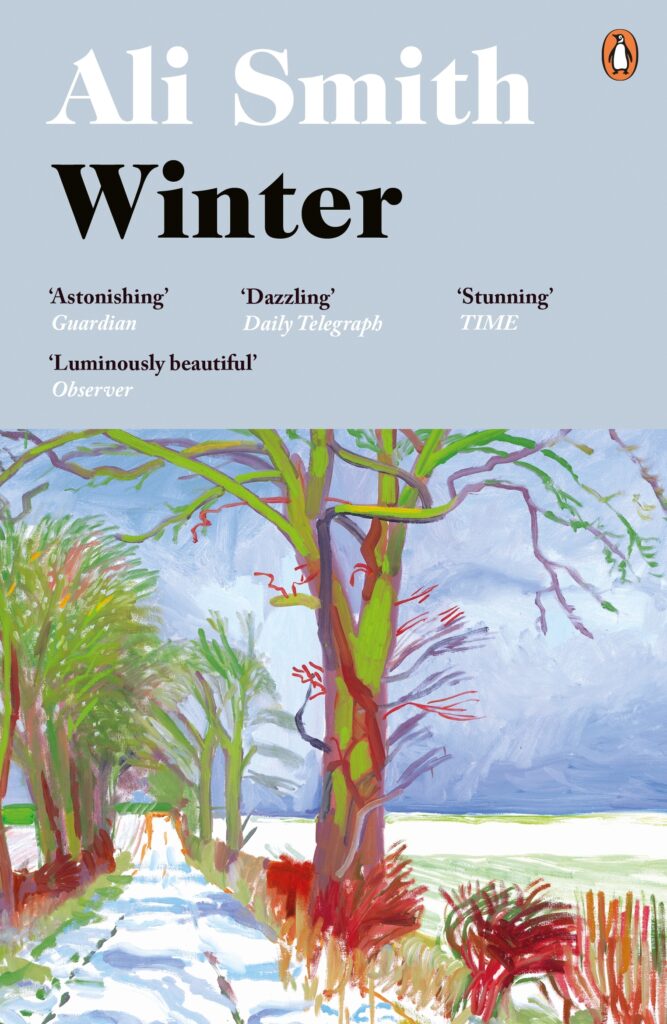Review | Winter

This is a review of Ali Smith’s Winter

When we look back on right now – 2017, nearly Christmas, in the midst of one of the biggest man-made humanitarian crises – will we be tempted to mythologise it so that it becomes bearable after the fact? Ali Smith’s Man Booker-nominated novel, Autumn, was published last year barely four months after the Brexit referendum date was announced. Her second novel in the seasonally-themed series, Winter, is now published nearly a year after Trump was elected President of the United States. The reality of the present state of the world looms large over this novel, like a mystery blue-black bruise blooming overnight, only it’s a collective injury, and we’re still asking ourselves: how did we get here?
On the surface, this novel could’ve been a BBC miniseries-style comedy of errors: a dinner party gone wrong, a jumble of people from different walks of life who are thrown together by bloodlines and circumstance and the everyday conflict in trying to survive one of the harshest seasons of the year. But trusted to the mind of Ali Smith, this novel becomes a brain puzzle inspired by Charles Dickens: similarly to A Tale of Two Cities, we are given a story that tries to tell us we can inspect something at arm’s length even though it’s not certain yet whether we’ll survive it.
Winter is bookended by two pieces of English art nearly ten years apart in existence – the cover image, David Hockney’s Winter Tunnel With Snow, March (2006) and on the inside back cover, Barbara Hepworth’s Winter Solstice (1971). Both look serene and unassuming like hotel art, despite the flashes of violent imagery that glimmer in conversations, private thoughts, deliberate wordplay throughout each chapter – researchers leaving human corpses to rot in fields to observe them deteriorating in real time, rivers of blood, cities in ruins because of The War. Both appear removed from the kind of art that evokes the risk in protest: for example, the late Gordon Parks (who documented civil rights, racial inequality, and poverty in America) or Nancy Spero (a political feminist painter who was known for protesting by throwing pies in people’s’ faces).
In a different novel, characters might resemble versions of ourselves or people who we might see walking the streets, but Winter seems occupied by people-as-statements: prickly Sophia, a mother who is followed by a floating baby’s head stuck in the corner of her eye (like a postmodern A Christmas Carol); Arthur (Art) who has a day job in reporting copyright infringement but really wants to be a nature writer; Lux who is a clever student but often underestimated; Iris (Ire), a former protester and lifelong activist.
Lux is easily one of the most compelling characters in the novel, and it’s a shame she doesn’t get more dialogue or room to exist in Winter. She has a “deg” (the first half of a degree) which she was unable to finish after running out of money, and has been paid by Art to pose as his girlfriend for Christmas to avoid the I-got-broken-up-with conversation with his mother. It’s clear that she’s uninvited and a bit of an unexpected surprise in Sophia’s fifteen-bedroom Cornwall residence: Lux’s name is compared to soap flakes by Art’s family at dinner; there are unspoken rules around communal spaces she has to be careful of while she spends the holidays in a home that isn’t hers. Despite being “a clever clogs egghead smarty pants brainiac nerd”, she comes to Britain with low expectations – even with everything she’d accomplished, ”the earth didn’t move for me” she tells Art on Boxing Day morning.
For a novel that deals with post-truthiness – the death of objective facts in favour of appealing to emotion and personal beliefs – it isn’t long before a complaint about narcissistic millennials (from Iris, who doesn’t see any issue in owning an iPad) happens halfway through. It’s odd and slightly unnerving to read about made-up people discussing how their tweets are performing, and how many followers they have, and stressing about whether their online presences are authentic enough. Similarly, entries from Arthur’s blog, Art in nature read like they could collectively be a Tinyletter experiment.
A failure of Winter, and perhaps literary fiction by extension, is trying to challenge that ‘is it too soon?’ window by presenting the more mundane moments outside of the newscycle: the emails we send to friends and family to try to make sense of things, the roundabout conversations we have with each other in the not-important hours of the day, the stories and advice our parents give us that didn’t ‘make the cut’ because it wasn’t pithy (or tweetable). Perhaps this book is ahead of its time. Perhaps not everything can be fictionalised into an artefact that ends up in a museum.
Midway through the novel, at the dinner table, Lux contributes to a discussion at the family dinner table. Breathless, she observes, “…everybody is pretending to be someone or something else. And you can’t see for the life of you how any of it will resolve in the end, because it’s such a tangled up farce of a mess.” She could be talking about a Shakespearean play. She could be talking about the novel she’s in. She could be talking about the moment we’re living in now.

